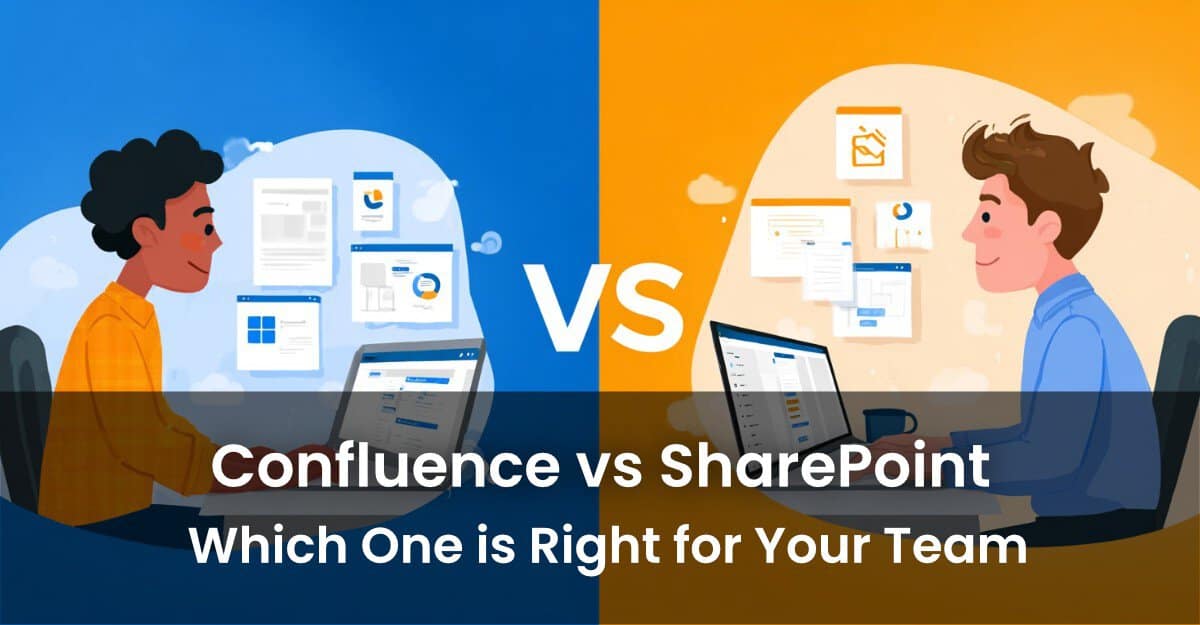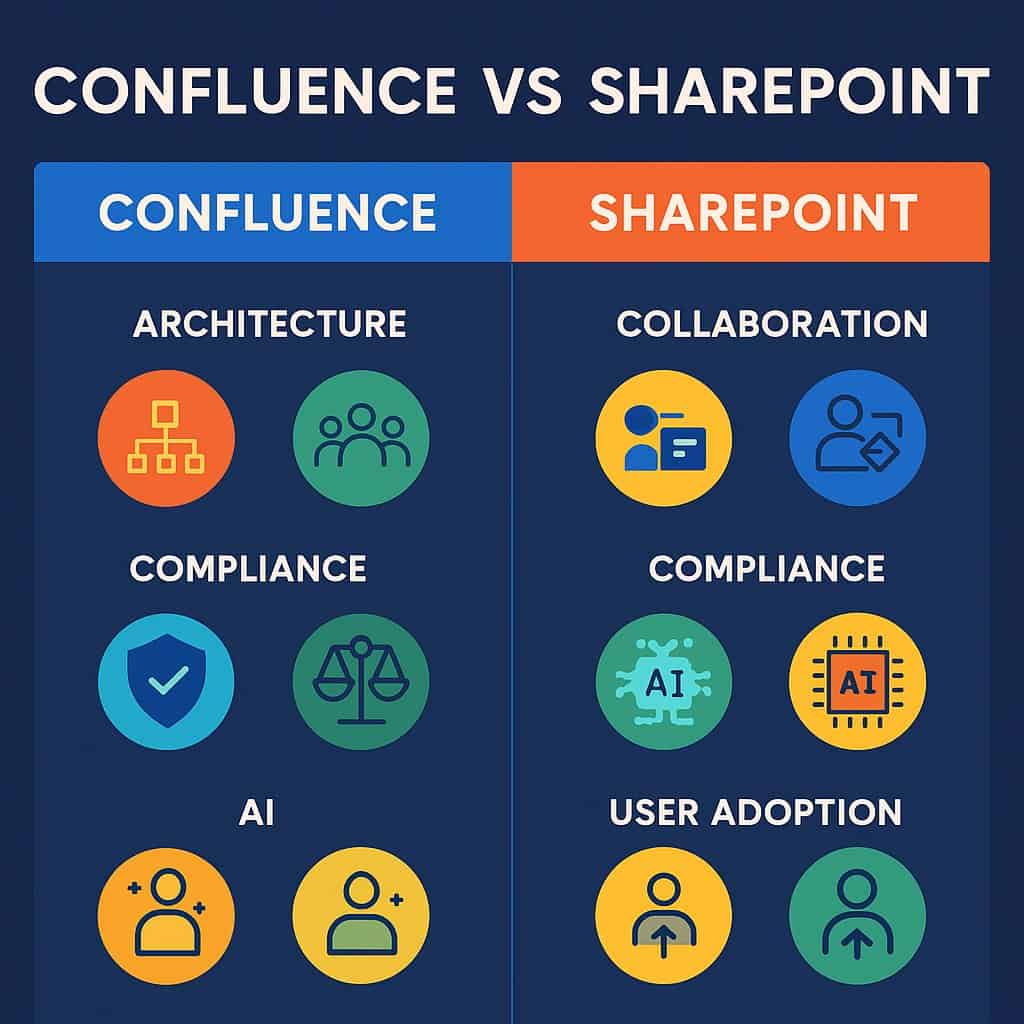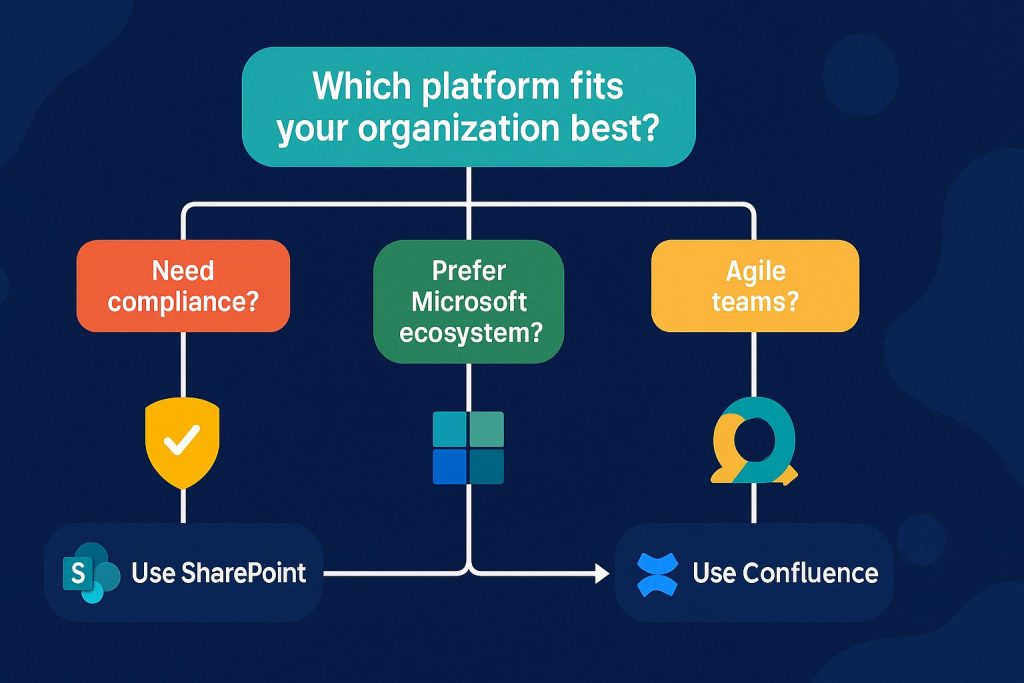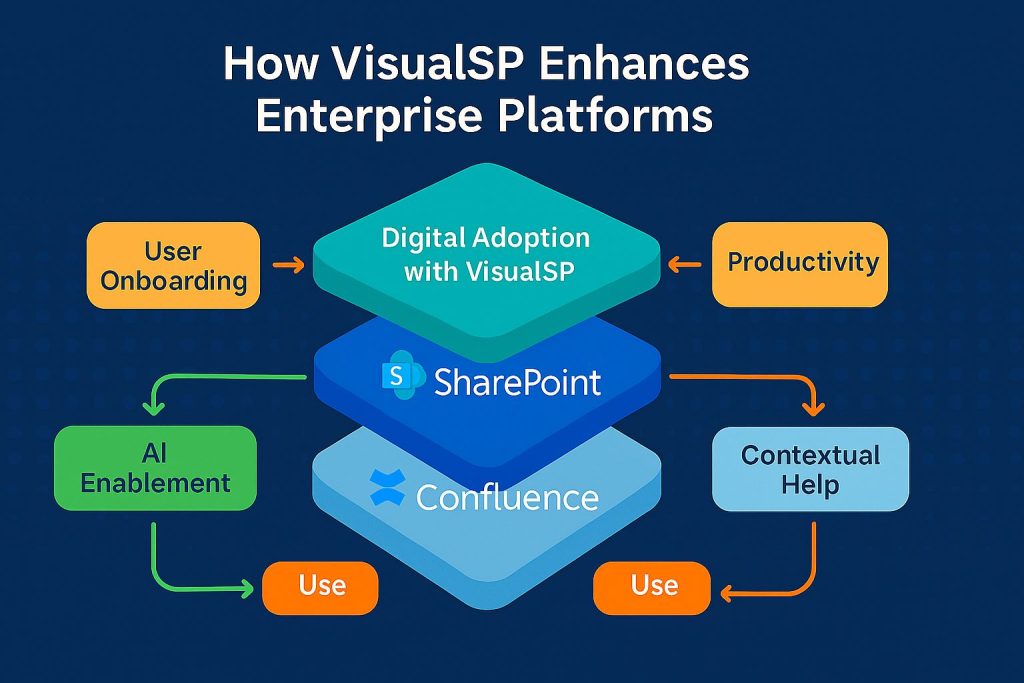
As organizations become increasingly reliant on digital tools to manage information, collaborate across departments, and maintain compliance, the need for robust document management platforms becomes critical. Among the most commonly evaluated platforms in enterprise environments are Confluence and SharePoint. Both tools are widely adopted and offer unique capabilities, but their fundamental design philosophies and technical architectures differ significantly.
In this article, I’ll present a detailed, first-hand comparison of Confluence vs SharePoint. My objective isn’t to declare one tool universally superior but rather to help enterprise decision-makers understand the nuanced differences. This article explores everything from information architecture to AI readiness, integrating over a decade of experience in digital transformation and system integration. I’ll also touch on how digital adoption and intelligent enablement play an increasingly strategic role.

Document management is no longer just about storing files. In today’s enterprise landscape, it's a foundational capability that drives knowledge sharing, regulatory compliance, and operational efficiency. Whether it's engineering documentation, legal archives, or project notes, every organization needs a structured yet flexible system to house its institutional knowledge.
Enterprise environments are evolving rapidly. Teams are distributed, workflows are increasingly automated, and data security is paramount. Against this backdrop, the choice of a document management system influences not only productivity but also the organization's ability to scale and adapt.
Digital transformation is a strategic imperative across nearly every sector. As businesses digitize operations, they demand platforms that are agile, extensible, and intelligent. AI is also playing a transformative role, particularly in how users search, summarize, and interact with organizational content.
In this climate, choosing between Confluence and SharePoint is less about comparing wikis to portals and more about aligning platforms to enterprise strategy. These tools don’t just support workflows; they shape them. Therefore, this comparison is as much about long-term alignment as it is about short-term features.
When clients ask me to help choose between Confluence and SharePoint, I guide them through a series of strategic questions:
The answers to these questions often dictate the direction more than any checklist of technical features.
Confluence and SharePoint are both powerful platforms, but they were built with fundamentally different purposes and user experiences in mind. Confluence, developed by Atlassian, is designed as a team collaboration and knowledge management tool, widely adopted by agile and technical teams for its simplicity and flexibility. SharePoint, a Microsoft product, serves as a comprehensive enterprise content management system with strong capabilities in document governance, workflow automation, and integration across the Microsoft 365 ecosystem. While both tools support document collaboration, their architectures, permission models, and integration patterns reflect different priorities. A clear understanding of each platform’s core strengths is essential before assessing fit within your organization’s digital strategy.
Confluence, developed by Atlassian, is fundamentally a collaboration and documentation platform. It's widely favored in agile environments, especially in engineering and product teams. The tool encourages decentralized knowledge creation. Teams can spin up new pages, collaborate in real-time, and iterate on documentation without waiting for centralized approval or structure.
Its simplicity is one of its biggest strengths. Spaces and pages can be created rapidly, and the markdown-style editor makes it easy for technical teams to write documentation with minimal formatting constraints. However, that same flexibility can lead to content sprawl if not managed properly.
SharePoint, a Microsoft product, is designed with enterprise governance in mind. It integrates tightly with Microsoft 365 and excels in environments where content security, access control, and structured workflows are paramount. SharePoint is not just a document repository; it's a fully-fledged content management system that supports intranet portals, workflows, and even external collaboration.
SharePoint requires more upfront configuration, and its flexibility often comes with a steeper learning curve. But for organizations prioritizing compliance, versioning, and integration with tools like Microsoft Teams, Power Automate, and Outlook, SharePoint is difficult to beat.
These platforms are built on different ideologies:
Both are valuable, but they serve different needs. The key is to match the platform to your enterprise's culture and compliance requirements.
Understanding how each tool structures information is essential. Confluence organizes content through a hierarchy of Spaces and Pages. Each Space represents a broader topic or team, while Pages nest beneath Spaces in a parent-child relationship. This model is intuitive for smaller teams and projects.
SharePoint uses Sites and Document Libraries. Each Site can contain multiple Libraries, Lists, and Web Parts. Metadata and content types allow documents to be categorized and retrieved in highly specific ways. This makes SharePoint ideal for complex document lifecycles and regulated industries where discoverability and auditability are key.
As organizations scale, so does their content. Confluence’s hierarchical page model can become difficult to manage at scale. Without strong governance, it's easy to lose track of where information lives.
SharePoint’s metadata-driven navigation offers better scalability. You can create dynamic views, filter content by tags, and roll up documents across sites. However, this requires rigorous upfront planning and user training to implement effectively.
Confluence thrives with unstructured content notes, brainstorming, and product wikis. SharePoint, in contrast, is optimized for structured data documents with specific types, approval workflows, and retention policies. For organizations that need both, a hybrid model or careful integration strategy may be appropriate.
Document lifecycle management refers to the journey of a document from creation to archival. Confluence provides basic page history and permissions, but lacks built-in review workflows. You’ll need add-ons for structured approvals or publishing workflows.
SharePoint supports robust lifecycle policies. You can define content types, assign retention rules, and integrate with Power Automate for multi-step approvals. This makes it far more suitable as a long-term document management system.
Confluence offers a clear version history for each page, allowing users to compare versions and revert changes. It’s suitable for collaboration, but limited when it comes to legal or compliance-grade audit trails.
SharePoint provides item-level versioning for documents and lists. Coupled with audit logs and compliance center integration,eds enterprise-grade audit requirements. This is crucial for industries like finance, healthcare, and legal.
In Confluence, tagging is handled through labels and page hierarchies. It’s effective for informal classification but lacks enforcement.
SharePoint’s metadata model allows for structured classification using content types, managed metadata, and term sets. You can build powerful taxonomies that align with your business domain, enabling granular content policies.
Confluence’s native search has improved over time, especially with Atlassian Intelligence, but it still lacks advanced search operators and cross-site indexing.
SharePoint’s enterprise search is powered by Microsoft Search and integrates with the Microsoft Graph. It supports keyword query language (KQL), content-based search, and user-based relevance. This makes it significantly more powerful in organizations with large content volumes.
Confluence supports real-time collaboration, but only on a page-by-page basis. Multiple users can edit the same page, and changes are saved incrementally.
SharePoint allows co-authoring on Office documents via Word, Excel, or PowerPoint Online. It’s seamless when integrated with OneDrive and Teams. Users can see who’s editing, comment inline, and avoid overwrite conflicts.
Both platforms have modern editors, but the philosophy differs. Confluence offers a simplified page builder with macros, tables, and templates. It’s intuitive for frequent contributors.
SharePoint’s authoring experience is modular, relying on Web Parts and modern pages. While powerful, it’s more complex and can confuse users unfamiliar with SharePoint's architecture.
Confluence provides inline commenting, mentions, and notification settings per page or space. It encourages back-and-forth discussions within the context of the content.
SharePoint integrates with Outlook and Teams for alerts and notifications. Comments on documents are supported through Office files, but SharePoint doesn’t offer page-level threaded discussions.
This is where usability gaps become apparent. SharePoint’s powerful features often overwhelm users. It’s not uncommon for business users to struggle with permissions, libraries, and document check-in/check-out workflows.
Confluence’s lower barrier to entry can speed up onboarding. Teams can start documenting right away without deep training.
Many organizations deploy digital adoption platforms to close this usability gap, especially with SharePoint. VisualSP, for example, provides in-context training and guidance, enabling business users to navigate complex environments without formal instruction.
Confluence allows page and space-level permissions that are relatively easy to understand but not always granular enough for complex organizations. For many teams, the ability to restrict editing or viewing at a page level is sufficient. However, for enterprises with strict access control policies, the limited role hierarchy may pose challenges.
SharePoint offers much deeper control. Permissions can be applied at the site, library, folder, or individual document level. It supports role inheritance, security groups, and integration with Azure Active Directory. This makes it more suited to organizations where compliance mandates fine-grained access controls.

SharePoint provides built-in support for audit logs, retention policies, and records management. These features allow compliance teams to track user actions, enforce document lifecycles, and manage content disposition in line with legal requirements. SharePoint’s integration with Microsoft Purview enhances these capabilities.
Confluence includes a version history and a basic audit trail, but lacks comprehensive native tools for long-term compliance. Some third-party apps can fill the gap, but this adds complexity and cost.
SharePoint complies with many industry standards out of the box, including GDPR, HIPAA, ISO 27001, and more. Organizations in finance, healthcare, and government often lean toward SharePoint specifically because of this compliance readiness.
Confluence Cloud meets standard security certifications, but Data Center deployments may require additional configuration and audits to meet strict compliance needs. For global enterprises, this variability can be a deciding factor.
Both Confluence and SharePoint support extensive integration capabilities, but they are rooted in different ecosystems. SharePoint benefits from its tight coupling with the Microsoft 365 suite. This allows seamless integration with tools like Teams, Outlook, OneDrive, and the broader Power Platform. These integrations are native and don’t require additional connectors for common use cases such as document approvals, task assignments, and alerts.
Confluence, on the other hand, integrates deeply with Atlassian tools like Jira, Bitbucket, and Trello. This makes it especially attractive to software engineering and product teams. Atlassian's Marketplace also offers thousands of third-party add-ons, ranging from diagramming tools to integrations with CRM and ERP systems. However, some integrations require additional licensing or manual configuration.
For enterprises building custom solutions or extending platform functionality, both tools offer rich APIs. SharePoint provides REST APIs Microsoft Graph API, SharePoint Framework (SPFx), and the, which allows developers to build client-side web parts and extensions.
Confluence offers REST APIs and supports custom macros using Atlassian's Forge or Connect frameworks. While Forge abstracts infrastructure to simplify app development, it may feel limiting to developers seeking full-stack control. SharePoint’s SPFx gives more control but requires deeper technical expertise and integration with Azure.
Workflow automation is another area where these platforms differ. SharePoint leverages Power Automate to create sophisticated, multi-step workflows that can interact across the Microsoft ecosystem. These include document approvals, notifications, task assignments, and more. The learning curve can be steep, but the functionality is powerful and scalable.
Confluence includes basic automation features such as page creation triggers, notifications, and minor task routing. For more complex workflows, teams usually rely on third-party apps like ScriptRunner or Integrate.io. These tools are capable, but they often require more setup and maintenance.
Artificial Intelligence is rapidly reshaping how organizations manage and interact with content across platforms like Confluence and SharePoint. AI features such as content summarization, intelligent search, and automated recommendations enhance productivity by reducing the time users spend locating or generating information. SharePoint, through Microsoft 365 and tools like Microsoft Copilot, offers deeply integrated AI capabilities that leverage organizational data to deliver context-aware assistance. Confluence is also evolving in this space with Atlassian Intelligence, which focuses on AI-driven search and content suggestions tailored to team activity. Ultimately, AI's role isn't just about automation, it's about augmenting human decision-making and enabling faster, smarter collaboration across the enterprise.
Microsoft has invested heavily in integrating AI across its productivity suite. SharePoint now benefits from Microsoft Copilot, which brings AI-powered summarization, intelligent search, and document drafting capabilities directly into the user interface. Copilot can surface content based on user intent, highlight key information, and even create pages or presentations based on existing data.
This AI capability is deeply integrated with Microsoft Graph, meaning Copilot understands user behavior, relationships, and historical actions. It significantly reduces the time spent searching for documents and enables smarter decision-making based on contextual insights.
Atlassian has introduced Atlassian Intelligence to bring similar AI capabilities to Confluence. These include AI-assisted search, automatic summarization of long pages, and content recommendations based on team usage patterns. While promising, Atlassian's AI features are still evolving and tend to be more narrowly focused on knowledge discovery and content creation support.
The AI experience in Confluence is more page-centric and less integrated across the broader enterprise toolset. That said, it adds significant value for teams looking to manage knowledge effectively within Atlassian's ecosystem.
When considering AI for business, the level of AI maturity and integration across tools is a critical differentiator. SharePoint’s advantage lies in its integration with enterprise-wide signals via Microsoft Graph, allowing for richer, more context-aware recommendations. For organizations embedding AI in business processes, this depth is important.
Confluence offers a lighter-weight AI experience that works well in teams focused on content creation and documentation. It can still drive value, particularly in agile environments, but may fall short in enterprise-wide AI strategy alignment.
In both cases, AI effectiveness depends heavily on adoption. Users must know how to interact with the tools, interpret outputs, and trust recommendations. This is where digital adoption strategies become essential, particularly when rolling out new AI capabilities across distributed teams.
When evaluating Confluence and SharePoint, understanding their deployment options is crucial for aligning with your organization’s infrastructure, compliance, and scalability needs. Confluence offers both Cloud and Data Center editions. The Cloud version is managed by Atlassian and is ideal for organizations seeking low-maintenance, automatically updated environments. In contrast, Confluence Data Center supports on-premises or self-managed hosting, giving enterprises more control over data residency, customization, and regulatory compliance. SharePoint follows a similar pattern, with SharePoint Online as part of Microsoft 365 for cloud-based access, and SharePoint Server for on-premises deployments that require granular control over infrastructure and integration. Choosing the right model depends on factors such as IT resources, security posture, latency requirements, and regional data governance.
One of the first technical decisions an enterprise must make when evaluating Confluence vs SharePoint is whether the solution should be hosted on-premises, in the cloud, or in a hybrid model. Confluence offers two primary deployment models: Confluence Cloud and Confluence Data Center. The Cloud version is managed by Atlassian and includes automatic updates and scalability, while Data Center offers self-managed deployment with higher control, often used by large enterprises with specific data residency or compliance needs.
SharePoint offers a similar split: SharePoint Online, which is part of Microsoft 365, and SharePoint Server for on-premises deployment. SharePoint Online benefits from tight integration with Microsoft’s cloud infrastructure, continuous updates, and native compliance with Microsoft’s global data centers. SharePoint Server is often chosen by organizations that require complete control over infrastructure or that have not yet moved to the cloud.
Both Confluence and SharePoint Cloud deployments are multi-tenant environments by default, although Confluence Data Center can be configured in a single-tenant, private-cloud setup. Microsoft 357 offers more mature capabilities for global distribution, including support for multiple geographies, regional datacenter selection, and advanced content delivery through Microsoft’s global CDN.
For organizations with global teams, SharePoint Online typically provides superior performance and latency optimization. It supports features like multi-geo tenancy, allowing data to reside in specific geographic locations. Confluence Cloud has made progress, but still lags behind in offering equivalent global scalability features.
When it comes to uptime guarantees, Microsoft offers a financially backed 99.9% SLA for SharePoint Online. Disaster recovery and high availability are managed automatically across Microsoft’s infrastructure. SharePoint Server deployments require the organization to manage its own HA/DR strategy, including database replication and redundant network architecture.
Atlassian also provides a 99.9% uptime SLA for Confluence Cloud Premium and Enterprise customers. Confluence Data Center deployments require customers to implement their own HA/DR strategies, including clustered deployments, load balancing, and backup policies. While both platforms offer robust options, SharePoint Online delivers more out-of-the-box enterprise resilience.
Licensing models for Confluence and SharePoint vary widely and can have a major impact on total cost of ownership. Confluence is licensed on a per-user basis, with pricing tiers that differ by functionality and support. Confluence Standard and Premium plans cater to most mid-sized to large organizations, while the Enterprise tier offers advanced admin controls and security options.
SharePoint Online is typically included in Microsoft 365 licensing bundles, such as E3 and E5 plans. This can simplify procurement and reduce incremental licensing costs for organizations already in the Microsoft ecosystem. SharePoint Server, by contrast, requires both server and client access licenses (CALs), making it more complex and potentially costly in on-premises deployments.
Direct licensing costs are only one component of platform investment. Customization, user training, support, and administrative overhead contribute significantly to the total cost of ownership. SharePoint’s depth often requires skilled administrators, architects, and sometimes developers to fully realize its potential. Custom workflows, site designs, and integrations often involve professional services.
Confluence generally has a lower barrier to entry and lower customization overhead. However, larger deployments often require third-party add-ons for functionality parity with SharePoint, which can drive up costs. Admins may also need to manage user permissions and space governance manually without centralized policy control.
Cost-efficiency depends on how well the platform aligns with your strategic goals. SharePoint may cost more up front, but it delivers stronger value when leveraged for compliance, records management, and enterprise-wide collaboration. Confluence offers quick wins for teams that prioritize agility, iteration, and lightweight documentation.
However, the biggest variable in long-term ROI is user adoption. If your team struggles to understand or utilize platform features, the value of even the most advanced system erodes. That’s why organizations often turn to digital adoption platforms to streamline training, reduce support costs, and maximize the impact of their technology investments.
Even the most advanced document management systems fail if users don’t adopt them effectively. In many enterprise rollouts, I’ve seen technically sound platforms underperform simply because employees didn’t understand how to use them or why they should. Digital transformation doesn’t happen through software alone; it requires people to change how they work. That’s why adoption is not a peripheral concern, but a core part of strategic planning.
The contrast between SharePoint and Confluence becomes stark here. SharePoint, while powerful, can overwhelm new users with its layered architecture, permissions complexity, and inconsistent UI behavior across sites. Confluence tends to be more forgiving, but its strength in speed and simplicity can lead to messy sprawl if not managed well. In both cases, thoughtful enablement is critical.
Here are some of the common barriers I encounter in organizations deploying these platforms:
These problems are not solved with one-off training sessions or documentation repositories. What’s needed is continuous, contextual guidance.
This is where digital adoption platforms (DAPs) play a significant role. Rather than expecting users to read manuals or attend multiple training sessions, DAPs provide in-app, just-in-time support. VisualSP, for instance, overlays guidance directly within SharePoint or Microsoft 365, showing users how to complete specific tasks within the interface they’re already using.
This approach dramatically reduces friction during onboarding and improves retention of key workflows. In complex environments like SharePoint, where permissions, site templates, and metadata can confuse even power users, a DAP becomes an enabler of productivity. It helps non-technical users navigate the system without depending on IT support.
In my experience, organizations that invest in structured digital adoption strategies achieve higher ROI, better data hygiene, and greater cross-team consistency. It’s one of the most underleveraged areas in enterprise IT planning.
Many enterprises don’t choose between Confluence and SharePoint; they use both. This often happens organically. DevOps and engineering teams prefer the agility of Confluence, while compliance, HR, and legal departments depend on SharePoint’s governance features.
This coexistence can work well, but it introduces challenges in knowledge discovery, duplication, and version control. Users might find themselves searching both systems for the same content or updating one while the other becomes stale.
Bridging Confluence and SharePoint requires deliberate planning. Some common strategies include:
While these integrations don’t eliminate friction, they reduce silos and improve collaboration between departments that prefer different tools.
Migrating from one platform to the other is rarely trivial. Differences in architecture, metadata, and permissions mean a lift-and-shift migration is rarely possible. Organizations need to:
Whether you're consolidating platforms or planning for coexistence, having a migration roadmap is essential to prevent disruption.
To help summarize the differences, here’s a comparison across key categories:
| Category | Confluence | SharePoint |
|---|---|---|
| Architecture | Spaces and Pages | Sites and Libraries with Metadata |
| Collaboration | Page-centric, flexible | Document-centric, integrated with Teams |
| Search | Basic to intermediate | Enterprise-grade, Microsoft Graph-backed |
| Compliance | Limited native features | Advanced compliance and retention tools |
| Extensibility | Atlassian Marketplace | Microsoft Power Platform, SPFx |
| AI | Atlassian Intelligence | Microsoft Copilot, Graph-powered AI |
| Onboarding | Simple, fast | Steep learning curve |
| Digital Adoption | Often manual | Supported by DAPs like VisualSP |
This table won’t replace deep evaluation, but it provides a directional view for strategic alignment.
Selecting between Confluence and SharePoint goes beyond comparing feature sets; it's a strategic decision that hinges on organizational culture, technical environment, and long-term goals. Key factors to evaluate include:
Organizations with agile, developer-centric cultures may gravitate toward Confluence for its streamlined collaboration and fast-paced content creation. On the other hand, SharePoint offers unmatched depth in compliance, enterprise governance, and seamless Microsoft integration, making it ideal for environments where structure and oversight are paramount.
However, this isn’t necessarily an either/or decision. A hybrid model, supported by a strong digital adoption framework, can often deliver better results by combining the strengths of both platforms while minimizing user friction.
Success depends not only on selecting the right tool but also on ensuring meaningful engagement after deployment. User adoption, guided by effective change management and tools like digital adoption platforms, is where real value emerges. In this context, the true objective isn’t just content management, but enabling teams to access, share, and act on organizational knowledge with confidence and clarity.

At VisualSP, we’ve spent years helping organizations bridge the gap between technology and people. As a leading platform in digital adoption, digital transformation, and AI for business, our mission is to make enterprise software usable for everyone, regardless of complexity.
This article highlighted just how powerful yet intricate tools like SharePoint and Confluence can be. Without proper support, even the best document management systems risk low engagement and missed ROI. That’s where we come in. VisualSP integrates directly into your enterprise web applications to deliver real-time, in-context support. Whether you need walkthroughs, inline help, or embedded video tutorials, we make sure users get the help they need exactly when they need it without leaving the application.
We also understand that producing support content can be time-consuming. That’s why our platform includes AI-powered content generation, allowing you to create contextual help materials like walkthroughs and guides in minutes. With pre-built help content, a user-friendly interface, and enterprise-grade security, VisualSP gets you up and running faster while ensuring long-term scalability.
More than two million users at organizations like the NHS, Visa, and VHB have relied on us to reduce training costs, streamline user onboarding, and increase productivity.
We’re proud to support responsible AI adoption by helping organizations embed AI workflows into everyday tools while maintaining data privacy and security.
If you’re looking to maximize the value of SharePoint, Confluence, or any enterprise platform, let’s talk. VisualSP can help you turn your tools into transformation.
Ready to experience contextual AI support in action?
Request a personalized demo of VisualSP today and see how we can help your teams do more with less friction.
Fuel Employee Success
Stop Pissing Off Your Software Users! There's a Better Way...
VisualSP makes in-app guidance simple.